HUMANS OF THE ISLANDS - LILA CRICHTON
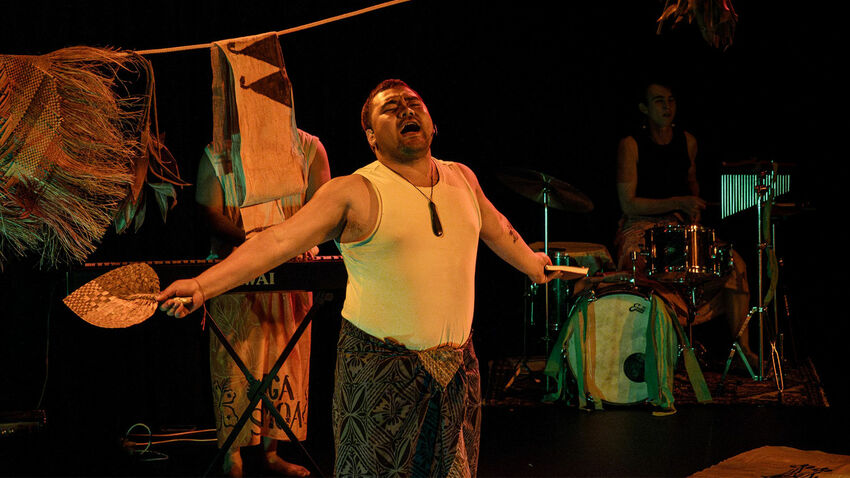
LILA CRICHTON
SAMOAN
OPERA SINGER
-
We spoke to Lila LJ Crichton is a NZ-born Samoan writer, director, composer and lyricist, ahead of his spring tour of A Master of None: Brown Fala, an evocative spoken-word theatre work, rich with original music and rooted in the rhythms of Pasifika storytelling. Crichton opens up about the creative path that led him from community halls to national stages, and how his journey of identity, language, and legacy continues to shape every note, line, and lyric he brings to life.
-
What drew you to storytelling, whether through music, theatre, or words? Was that something present in your upbringing?
For me, it was both fate and purpose. Being a Pacific Islander means a natural affinity towards stories and storytelling, and arcs as a means of expression. With the added layer of being in the diaspora — growing up in South Auckland and then moving to Flaxmere — I was never short of opportunities to be surrounded by storytelling.
At home, my family attended a Full Gospel Church called Voice of Christ, and my parents are now pastors of the Voice of Christ in Timaru. At school, I was a music kid, and I was part of almost every single extracurricular group — from the fashion team to the debating team, to Kapa Haka and choir.
My music teacher took me to an audition when I was 13 to be part of a youth performing arts initiative called Project Prima Volta. Through Prima Volta and Festival Opera New Zealand, I was introduced to the artform of opera. I was involved with Prima Volta throughout high school, and even worked as part of their team after studying at university. This was a free resource, which is insane — I never truly understood how valuable it was at the time, but I definitely know now. Because of that programme, I was able to explore the ins and outs of opera production — from artist liaison to management, and working with a director and stage manager to design lights, sets, costumes, and worlds.
It wasn’t until recently that I properly acknowledged I had been qualified for a long time to create my own shows.
I took a few years away from opera to fully learn what I had to offer. In those two years, I worked specifically in the commercial music scene, supporting different female artists like Aaradhna, Deva Mahal, Louisa Williamson, Mā, and Romi Wright. This taught me a lot about fighting to make sure you get the chance to tell a story — and fighting to make sure people hear it enough.
I also began developing my songwriting skill more and more, through exposure to these artists. Once I had enough songs prepared and built up, I began weaving stories using the songs. Then my flatmate Stela Dara, a dancer and director of Andança, messaged me one day saying: “Stuff it, I’m presenting a show at the NZ Fringe — come be a part of it.”
I was scared for her — but the entire process ended up being smooth. And working with those dancers made me realise I was being too precious, too much of a perfectionist. It lit a fire under me. I realised there’s no point being so sacred about the work — you just need to do it. So I followed her lead the next year.
Let’s talk about A Master of None: Brown Fala — where did this show begin for you? What sparked it?
So from what I’ve already mentioned, the biggest thing I couldn’t ignore was Brianna Fruean’s pre-pageant interview for Miss Samoa 2024. I had already decided I wanted to create a piece that felt like someone had genuinely walked into the backyard of your family’s house.
I had already decided I wanted to use different artforms from within my culture — showcasing our textiles, fashion, and rituals — so that it didn’t just feel like another theatre piece with Samoans in it, but rather a piece of Samoan theatre that a non-Samoan could piece together if they tried.
I was sitting there watching Brianna with my aunties and sisters — we were all in one place preparing for my little sister’s wedding — and Brianna dropped the line:
“We keep sweeping things under the same fala our children play and sleep on.”
Immediately my head started choosing from my songs, choosing Pacific Island stories, choosing performers — and the show formed itself from there.
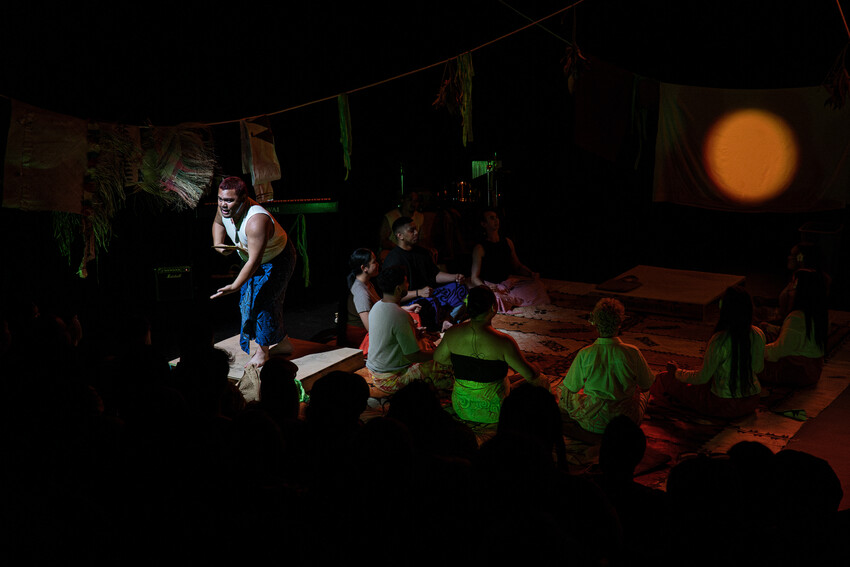
The title Brown Fala is loaded with meaning — what does the fala represent for you, and why did it feel right as the central metaphor?
Mainly the reason I’ve already shared, and also more justification: I wanted the show to reference the art of lalaga. It’s always fascinated me that you can have a fala and an ie toga, and two people outside of the Pacific would assume they’re the same thing — but the differences between them are astronomical in terms of what they’re used for, what they’re made of, where you would see them, and the etiquette and weight they carry.
In this world view, both are important. And because I — as a male — was writing a show about a history that historically always involves males, I wanted a name that had weight to it and implied something.
Brown Fala rolls off the tongue almost like a slur. It sounds condescending — and I wanted to use the way men are often villainised to turn heads.
There’s also an implication in the name: lighter fala (woven mats) are often seen as more valuable — their process approached with care. The implication of receiving a brown fala is that you’ve rushed the process and skipped a step.
That’s important, because my intention is not to talk about the inherent bad in anyone, but rather the carelessness, the lack of care — and how that affects everything. What needs to be done is to work backwards with care, to unweave something that seems locked in place, and reweave it with intention.
And finally, like Brianna’s quote and the visual aspect of an ifoga, we are talking about things that are swept under the rug — so the fala is what I went with.
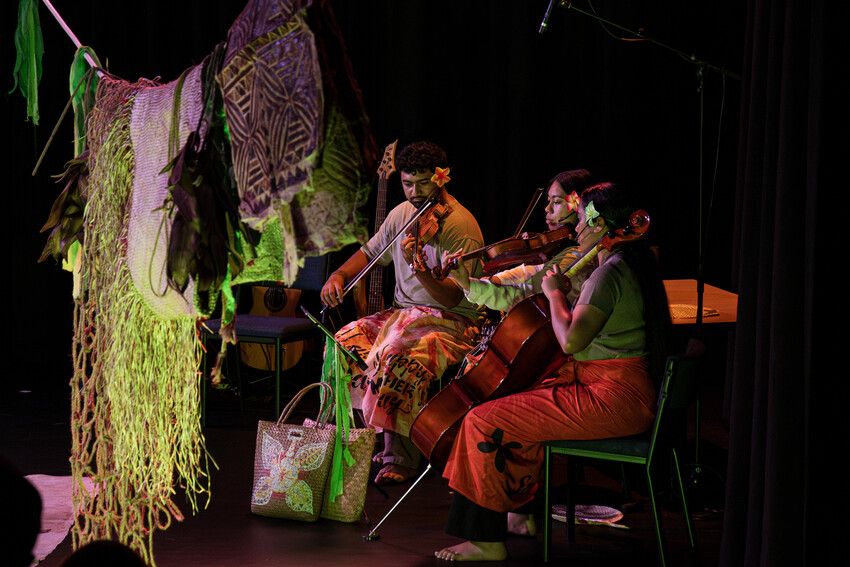
The show explores silence — both inherited and enforced — and the harm that can come from within our own communities. How did you approach telling those truths with both care and courage?
I was consulting with my own elders, as well as people of my generation, to understand how to properly communicate and initiate the conversation.
We talk about violence — against women, children, and queer people — in the show, and how it’s often normalised in the silence of the household.
It’s definitely a heavy topic, and in the end, I don’t offer solutions or claim to fix anything within an hour-long show. But coming back to the fala — what the show does suggest is an appreciation for what we already have: something symbolic within our culture that is designed as a meeting place. A space created to sit and talk.
The purpose of me creating the show is to encourage people to have those conversations. To speak up. But most importantly — to listen.
You’ve said “it’s messy under the fala.” What kind of mess were you ready to unravel with this work?
Originally, my brain went in a million directions. When you finally get a platform and acknowledge its potential as a tool for activism, your brain does go wild. There were so many conversations I wanted to bring to the table.
But I didn’t want to overwhelm the show, the cast, or the audience. So I decided to start with the one issue I felt had become the most normalised — the violence against women, children, and queer people that happens behind closed doors, and the fact that it rarely receives space for accountability, understanding, or forgiveness.
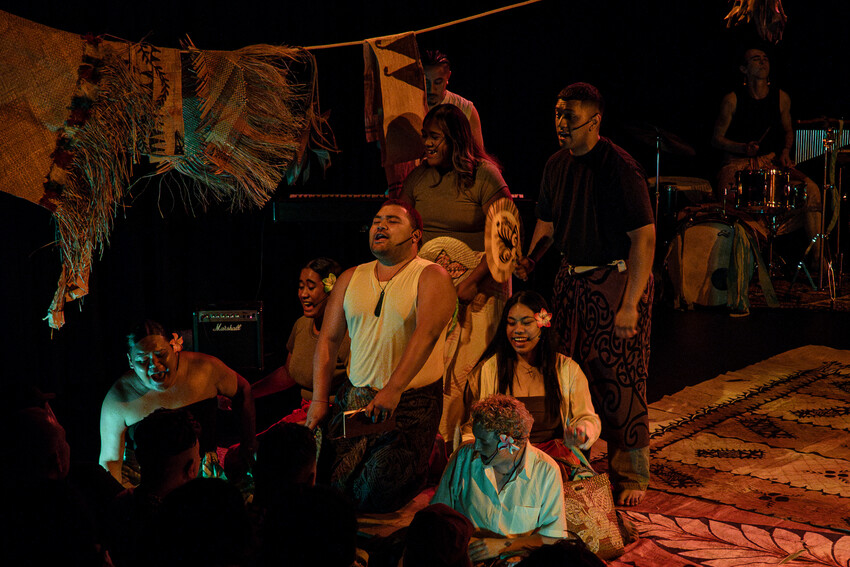
The piece is described as both a reckoning and a celebration. How did you hold space for rage, grief, joy, and humour all at once?
I never really intended to hold all of those emotions at once — but I did intend to include as much nuance of the culture as possible.
I invited very specific artists to be a part of the show, and they brought even more nuance and perspective into the room. There’s not a single part of the show where I hold back feedback or suggestions from the cast on where they think the beats should go. The product we have now is definitely a collaborative effort.
I told them where I wanted the heavy beats and the light beats — and they ran with it.
From my side, I knew I was speaking about violence against children, women, and queer people. So I tried my best to include childlike storytelling methods — the whole show is a retelling of the Samoan tale of Sina and the Tuna, with shadow play and animations.
I did this so that we could all feel like children watching the show innocently, and so the graphic scenes didn’t have to be graphic to be uncomfortable. I wanted to play with the unspoken, the messages between the lines — in a way that almost felt like I was laughing in the face of the audience, because the truth was so painfully obvious.
You’ve called it a “deeply personal and profoundly communal offering.” Who did you write Brown Fala for?
Yep — this was definitely a deeply personal and profoundly communal offering. I wrote it for my sisters, my mother, my aunties — and also my brothers, my father, my uncles. I wrote it about myself. I wrote it for my friends. I wrote it for my colleagues, my employers, and people outside of my culture who don’t have something like a fala.
I also wrote it for all the incredible female activists — of all generations — who’ve done the hard work to break silence and inspire others to do the same.
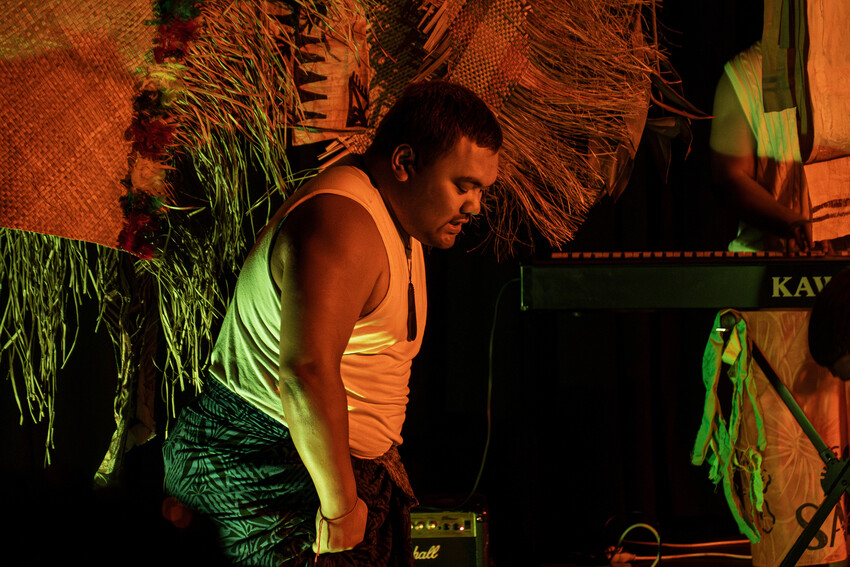
What have audience reactions been like? Has anyone’s response really stayed with you?
Yeah — I got a lot of validation after the first season at the NZ Fringe Festival.
I was nervous stepping into so many new roles — composer, writer, director, producer — but I received a lot of love for the care that went into selecting the cast and creating characters and storylines that used each person as a kind of secret weapon.
That meant a lot, because I spent so much time alone in my room just brainstorming who should be in the show, and why.
We had professional opera singers and classical musicians, Pacific storytellers who’ve performed internationally, professional barbershop singers, solo artists, activists, textile designers, thespians — and not a single person in the cast works in just one discipline.
That’s referenced in the title too: A Master of None — an ode to myself and my people. And it’s something we showed off successfully at Fringe and again at Kia Mau Festival.
What has this work taught you about your own story — and about the stories we carry as Pacific people in diaspora?
Actually, I’ve already started writing the next show — because I really loved creating something that felt genuinely and unapologetically Pacific.
Even while writing Brown Fala, I was meeting and collaborating with other artists and unknowingly starting the next project.
I now have a long list of people I want to write for, and a long list of stories I want to represent. I want the next show to feel very different from the atmosphere and aesthetic of Brown Fala — by tapping into the lives of individuals who were less visible in the last show.
I don’t need to — and don’t want to — just air all our dirty laundry for the world to see. This next work is about celebrating the parts of our culture I’m most proud of. Things I think we’re way ahead of the world in.
And finally — what would you say to other young Pacific artists trying to tell stories that feel heavy, honest, or outside the norm?
Yeah, we were really lucky during our last season because we had several school groups come through in large numbers, and some stayed for Q&As.
My answer then is still true now: Not starting is now your biggest obstacle — until you do. Don’t let lack of resources, lack of self-belief, or lack of support from others stop you from creating.
I took inspiration from collectives like Shifting Centre in Wellington — just a group of people who decided to go. From my flatmate who one day just did it. From No.3 Roskill Theatre, who put on shows in the park.
Not starting is your biggest obstacle. So start.
-
A Master of None: Brown Fala is being performed on 12 October in Napier (as part of Hawke's Bay Arts Festival), and 29 & 30 October in Christchurch. Ticket information can be found here!
